Brighton has emerged as a team with the potential to become a consistent mid-table side in the Premier League for years to come. Since Graham Potter’s arrival last year, Brighton have begun to identify themselves as a tactical nous and interesting, albeit a challenging, team to analyse, with Potter choosing to play in a variety of different formations last year. This year, however, Potter has begun to identify a more exact tactical system, focused on a core, young and talented squad that work in this system, a 3-4-3 that variates into a 3-4-2-1.
In this recruitment analysis, we will focus on Potter’s emerging young talent that plays in his tactical system, the transfer policy the team have begun to identify and implement more effectively, an overview of their current squad in terms of depth and quality and areas they may need to strengthen to continue to progress over the next few seasons.
The story so far
Brighton spent a few seasons in the Premier League under the tutelage of Chris Hughton and whilst he did an excellent job in keeping them in the Premier League following promotion, he was unable to re-invent and produce more progressive football. Brighton made a surprising and bold move at the time, bringing in Graham Potter from Championship side Swansea City. This decision has paid dividends, however. Potter had grown a reputation of building progressive, possession-based, attacking sides. Spending eight years taking Östersunds in Sweden from the fourth tier to the top of Swedish football, qualifying for Europa League football and even beating Arsenal at the Emirates. Having become the first Swedish side to progress beyond the Europa League group stage along the way.
Potter has built a tactical system based on versatility, with a number of his players being able to play in multiple positions comfortably. This tactical versatility allows them to play multiple systems and adapt based on their opponent. Brighton has, however, found a system that works in the majority of games, with a three at the back being preferred more consistently this season. However, they have played in a tried and tested formation of 4-2-3-1 in the Carabao Cup, showing Potter is still open to trying different formations to win.
Even after just five league games this season, which has consisted of Chelsea, Manchester United and an in-form Everton already, Brighton has continued to improve. To show this improvement on a statistical level, Brighton has shown incredible commitment to a pressing game, covering more distance on the pitch than any other side in the last campaign. They also finished 8th in passes per 90 last season, only behind the top sides in the league, as shown in the table below, and are 9th in this statistic so far this season.
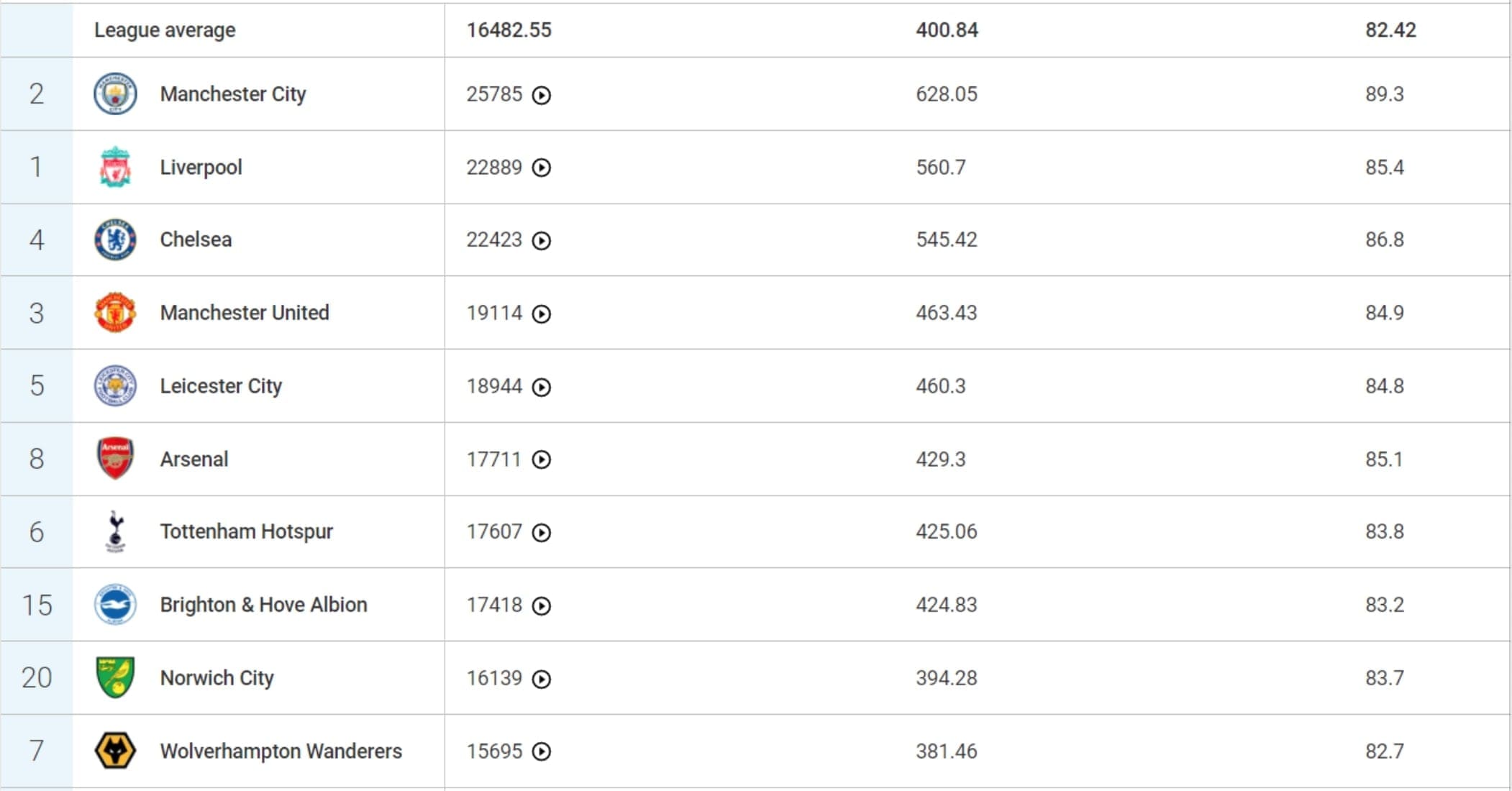

They also won possession in the middle third 951 times, ranking them 5th in the league and ranked 8th for PPDA (passes per defensive action), measuring how intensely they press against other sides, again putting them alongside the top sides in the league at 11.3. They are now 4th in the league so far this season, alongside the intensely pressing sides of Bielsa’s Leeds and Hassenhuttl’s Southampton.
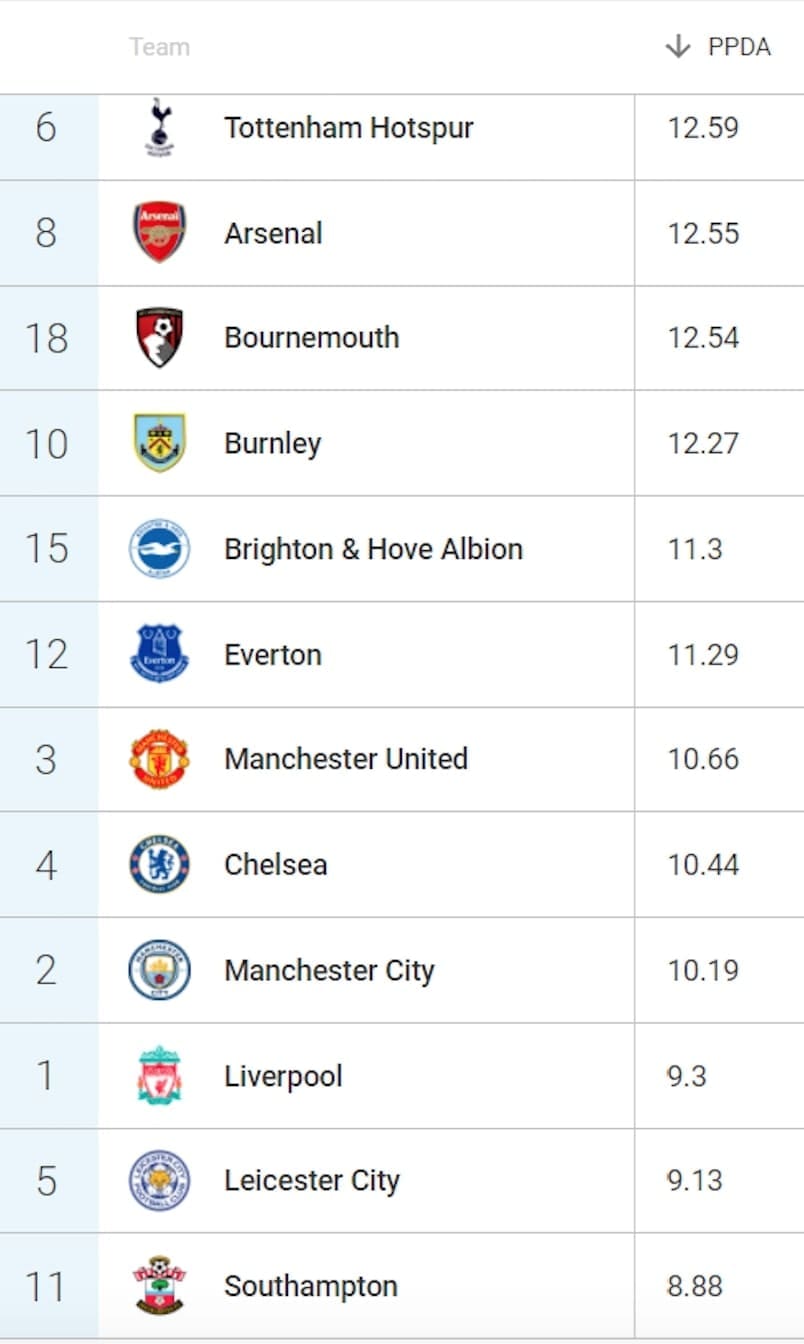
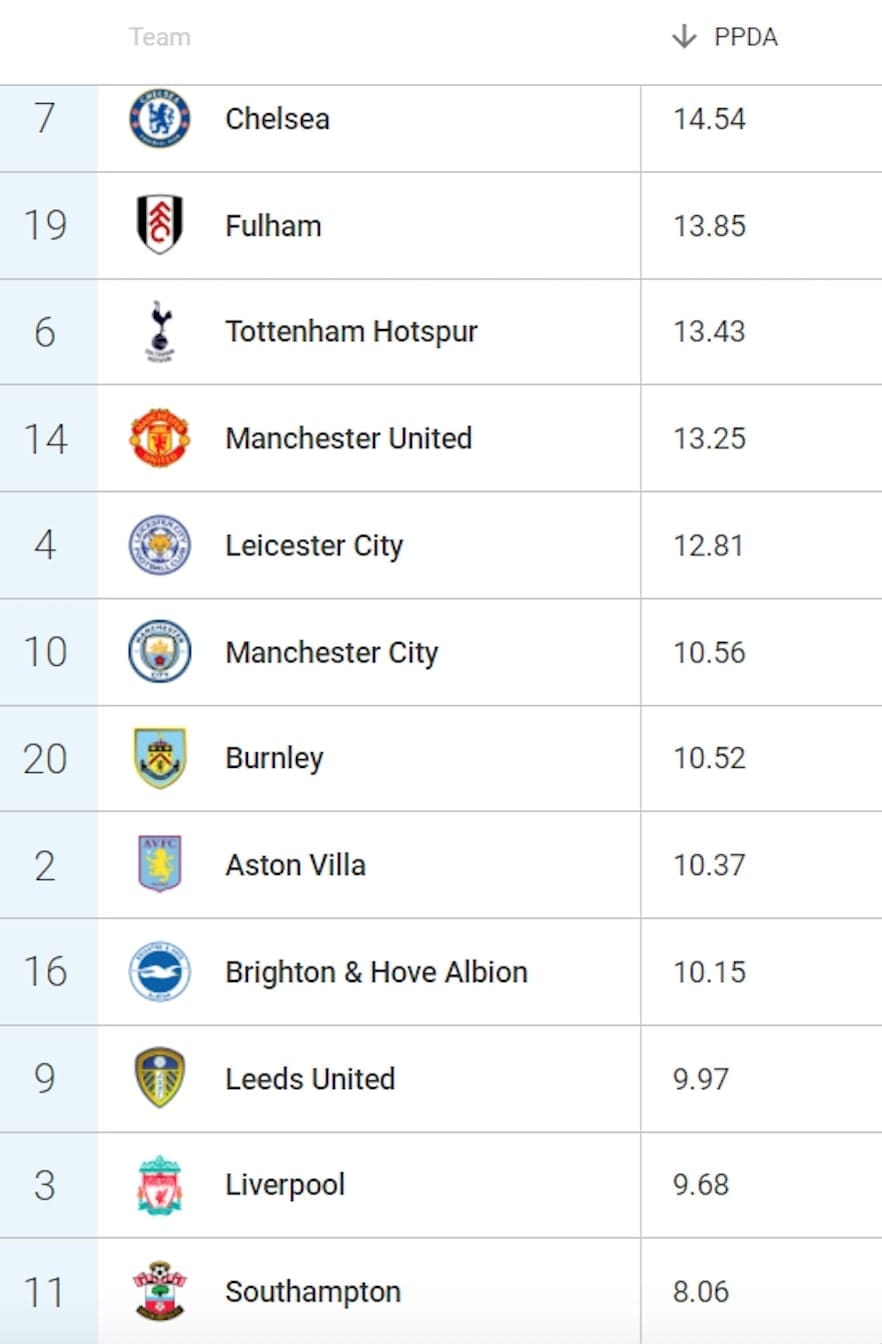
Brighton has built this intense, progressive and attacking side on a core of young, exciting players, namely Tariq Lamptey, Alexis Mac Allister, Ben White, Steven Alzate and Aaron Connolly. They have all become vital components of ‘Potterball’, and their recruitment/development is of enormous importance to their recent improving performances. What Potter is building here as he did at Östersunds and began to build at Swansea, is a side that plays with more intensity in the press, passes the ball more creatively and holds possession more effectively. A key area he will, however, hope to work on this season, is being more clinical in front of goal.
Current squad overview
This season, with a balanced amount of arrivals and departures, Potter is beginning to build a core side of players that bring something individual and unique to the team when the 18 is named. They have blended youth with experience nicely, with experienced players such as Lewis Dunk, Matthew Ryan, Adam Lallana and new signing, Danny Welbeck, bringing their knowledge and ability to their individual areas of the pitch in order to support and influence the younger players around them. Lallana is a particularly noteworthy addition, having signed on a free from the Premier League champions Liverpool, and still highly regarded by the Liverpool boss, Jurgen Klopp.
Brighton has also notably got the average squad age down under Potter and has their strongest, most important players on longer-term contracts. A good example of this is Ben White, who was strongly linked with the league’s top sides such as Liverpool but ended up signing a new four-year contract to stay at the club and become a crucial part of their first-team squad.
Ben White, specifically, brings a lot to Potter’s tactical system and is already showing signs of how he fits into the mould of what is required by a centre back in Potter’s system. The below heatmap showcases White’s versatility across the right-hand side and middle of the pitch, being utilised in central midfield for Leeds last season and for Brighton once already this year.
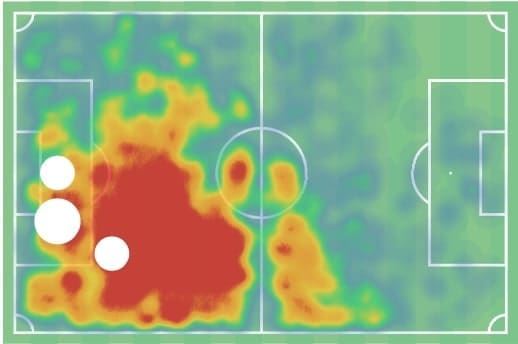
He plays a high line for a defender, pressing forward and involving himself in the build-up of attacking play. He ranks 12th for defensive duels in the league this season, and 3rd for dribbles, with the joint highest percentage success rate. He also ranks highly for progressive runs and progressive passes, in 10th and 7th. This showcases his ability to involve himself in attacking moves but also his capability to defend when required.
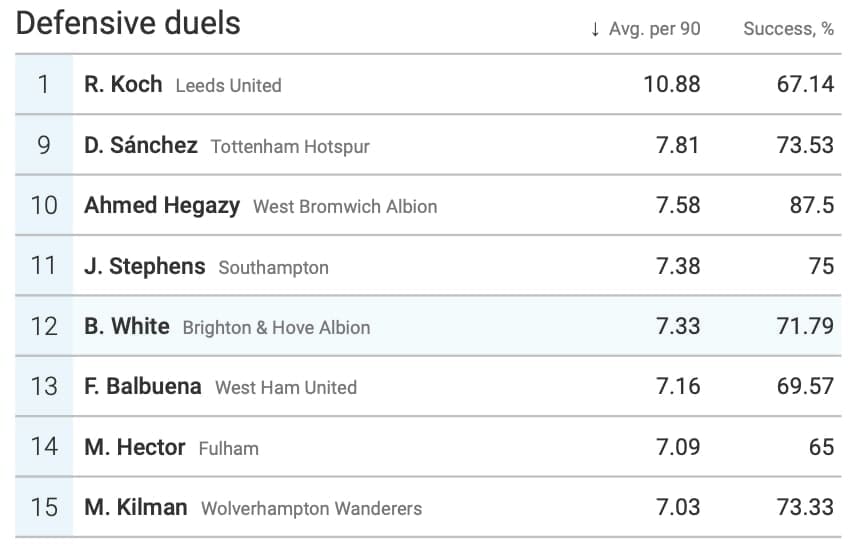


Tariq Lamptey has taken the league by storm this season, showcasing his ability as a potential future England right back, which is already an impressively well-stocked position for the national side. Lamptey was finding his route into the first team blocked by another rising star at Chelsea, Reece James, and his move to Brighton for just under 3 million will be seen as a coup by Brighton for years to come it seems.
Lamptey’s heatmap for this season shows how he hugs the byline, roaming up and down the right-hand side of the pitch and finding himself in high, attacking areas due to the 3-4-3 formation.
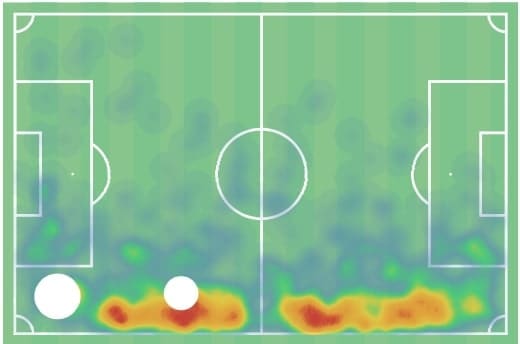
He ranks decently in defensive duels in 18th but highly in offensive duels in 4th, at 10.73 duels with a 55% success rate. He also ranks 6th for dribbles per 90 on 4.82 and 7th for progressive runs, showcasing his ability as an attacking threat in Potter’s system.

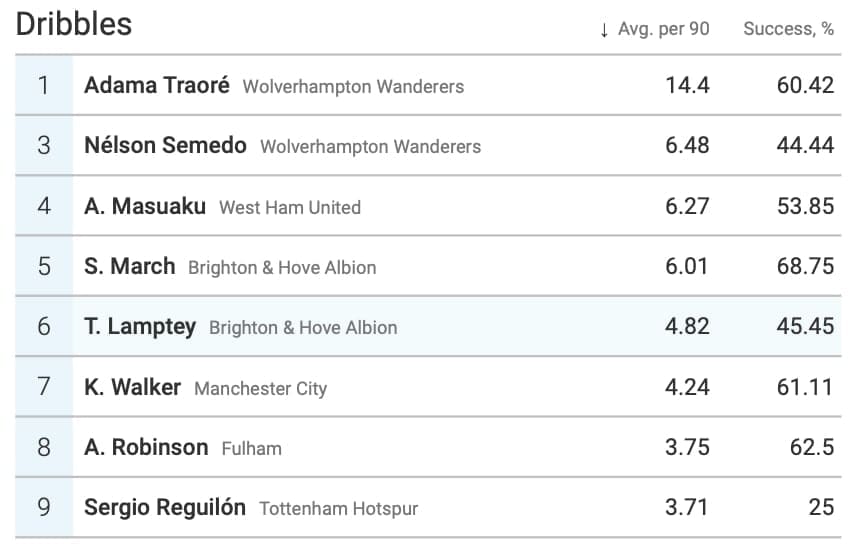
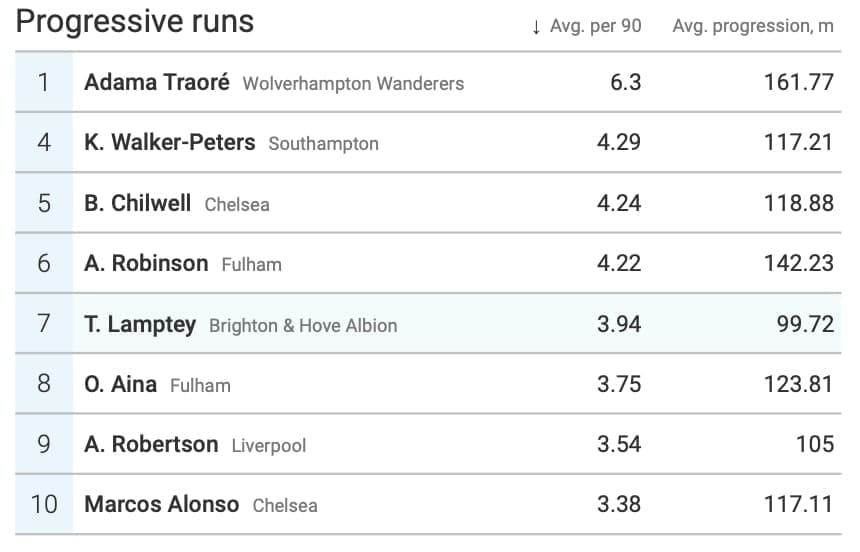
Both White and Lamptey are clear examples of the ‘Potterball’ system, ranking highly in progressive and attacking numbers in the league this season. But Potter will be wary of the vulnerability of his side when Lamptey and White find themselves further forward. Ensuring his tactics allow for these progressive runs to be made, with the other defenders and midfielders needing to cover each other in these movements to avoid a dangerous counter-press and counter-attacks.
The squad position analysis showcases Brighton have a variety of positions suitably covered in-depth, with their 3-4-3 complimenting the players at their disposal nicely. The need for two solid options in each position is vital to any top teams’ success, and Brighton has, for the most part, got this. They do, however, have noticeable gaps in numbers and quality, particularly on the wings and up front.
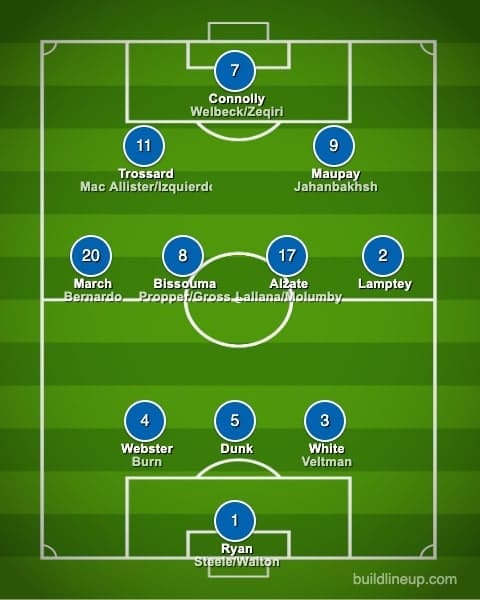
Neal Maupay and Aaron Connolly have the potential to be excellent strikers but have not been clinical enough up front. Brighton have a bright and emerging talent in Lamptey, and Solly March has emerged as a great attacking wing-back, but they don’t have a lot of quality depth behind these two. These are two key areas Brighton should look to target in the upcoming windows.
Potential additions
When looking at areas in which Brighton could strengthen, this piece will focus on one position specifically, the right wing-back position, due to the lack of depth and quality in this area. Whilst Veltman is a capable option in backup to Lamptey; he is more suited to playing at CB in the three at the back system or potentially as a right back in a four at the back system. Therefore, I have decided to focus on players playing at RB or RWB for clubs in the following leagues, as these are where Brighton have previously scouted from:
- England (Premier League, Championship)
- Belgium
- Netherlands
- France
- Spain
- Poland
The search field has then been narrowed down further, only focusing on players who played a minimum of 500 minutes in this position. I also tried to focus on younger players who showed good progressive attacking and defensive statistical metrics. I have then identified players that are best suited to Brighton tactically or could potentially adapt seamlessly into their style of play.
Future targets: a shortlist
Whilst Brighton will hope to focus their efforts on adding young talent, with Lamptey being the first choice in this position at just 20 years old, they may look for someone a little older and with more experience to compliment his youth and his growing talent. Here is a selection of players identified using key defensive and attacking metrics to show who Brighton could identify to bring in as an option alongside Lamptey:
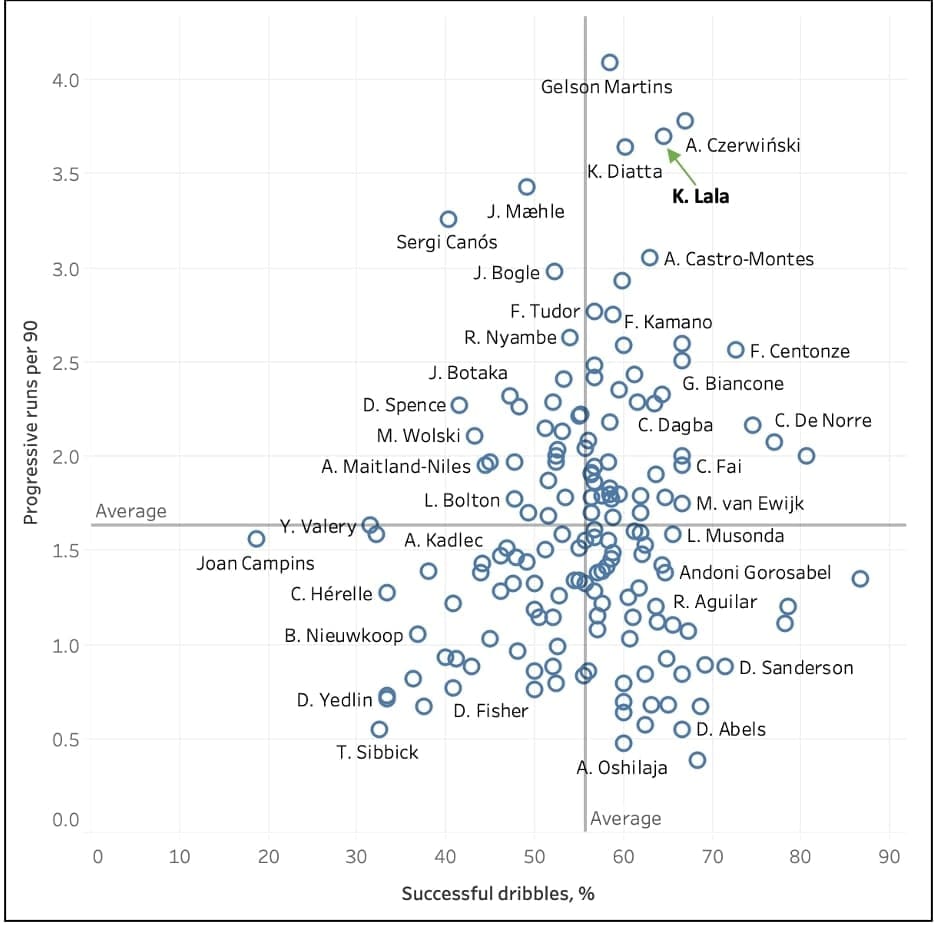
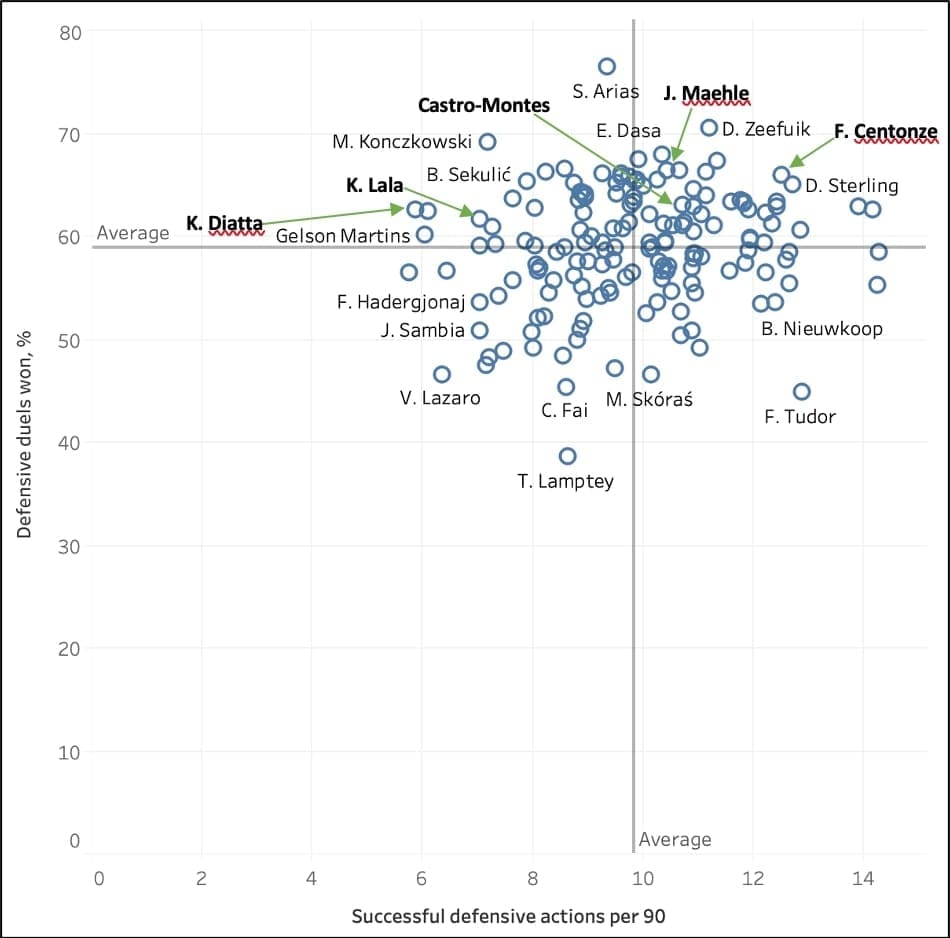
Kenny Lala (29 years old, RC Strasbourg, market value: £9m): This French player has become a key player in an inventive Strasbourg side, frequently playing at wing-back in a three or five at the back, matching him well with Potter’s tactical system. Whilst he is slightly older at 29 and probably reaching his peak potential already, he would be a capable and reliable alternate on either wing. In the absence of Lamptey, and his experience could help support and develop Lamptey as well even further. Whilst he does rank below average in successful defensive actions per 90, he ranks slightly above in % of defensive duels won. His attacking and progressive ability are what make him stand out as a reliable option for Potter’s side, with an above-average % of successful dribbles at 64% and a way above average of 3.7 progressive runs per 90.
Krepin Diatta (21 years old, Club Brugge, market value: £20m): The Senegalese right-winger has adapted himself into a right wing-back role in the past season, and this decision has paid dividends in his performances. His versatility to play further forward and contribute in the final third makes him a young, exciting option for Brighton in this area and further up the pitch. He is, however, perhaps too expensive for Brighton at £20m minimum. He does, however, have substantial numbers similar to Lala at right wing-back, with 3.64 progressive runs per 90 and 60% successful dribbles. An improvement in his defensive numbers over the season to come could, however, bring him out of reach for Brighton, especially with his involvement in Champions League football this season and the season before.
Joakim Maehle (23 years old, KRC Genk, market value: £10m): This Danish international has frequently been linked with Premier League sides, and it is a surprise to see he is yet to move elsewhere following the close of the delayed summer window. The right-back does display solid numbers, with 3.4 progressive runs per 90 and 10.44 successful defensive actions per 90, both above-average numbers in comparison to players in the leagues in question. He would be a younger and more defensive option to Lala but would perhaps cost more and may not have the experience that Brighton might be looking for the compliment Lamptey.
Alessio Castro-Montes (23 years old, KAA Gent, market value: £3m): This Belgian right-back is beginning to steadily make a name for himself in the Jupiler Pro League, scoring high metrics in both fields focused on in this piece. He ranks above average in all the metrics in question here, progressive runs, successful dribbles, defensive duels won and successful defensive actions per 90. Standing him out as a solid attacking and defensive option for Brighton, and at his current market value, he could present somewhat of a steal if he continues his solid form.
Fabien Centonze (24 years old, FC Metz, market value: £4.50m): This French right back bears strong similarities to Castro-Montes and presents as another excellent option for Brighton to pursue as a decent right-back option when called upon. His steady rise through the footballing pyramid has seen him rank well on the metrics in question, with his 72.73% successful dribbles being one of the highest of all the players discussed in this piece. He also ranks very highly in successful defensive actions per 90 at 12.52. Out of all the players mentioned here, he probably has the best spread of reliable numbers. At a market value of £4.5m, he represents a substantial investment for Brighton if they decide a new right-back/right wing-back is what they require in the upcoming windows.
Conclusion
In this recruitment analysis, we have focused on how Brighton has built a young, progressive and tactically versatile side, capable of strong performances regardless of the opponent. One of the key reasons Brighton have developed so significantly is the successful appointment of not just Graham Potter, but also their technical director, Dan Ashworth. Ashworth has brought his experience from the FA to the side and blended this perfectly with Potter’s ability to grow smaller teams into young, forward-thinking and attacking sides.
Their scouting networks expansion has allowed them to bring in potential stars for the future at a relatively low cost, with the high potential for a profit if and when they sell them on. This scouting network is also wider in scope than their rivals, meaning they are thinking ahead of other sides and continuing to innovate in the modern footballing climate. It will be interesting to see how Brighton’s youth talent develops this year with consistent and regular minutes, particularly Alzate, Connolly, White, Mac Allister and Lamptey.
Brighton does, however, need to continue to innovate in their transfer policy to succeed. They are in desperate need of a clinical and effective Premier League goalscorer, capable of finishing chances more frequently than their current forward options. They are also in need of better options on the wings, with versatile roaming wing-backs required to provide them with reliable options in the absence of the in-form Lamptey and March.

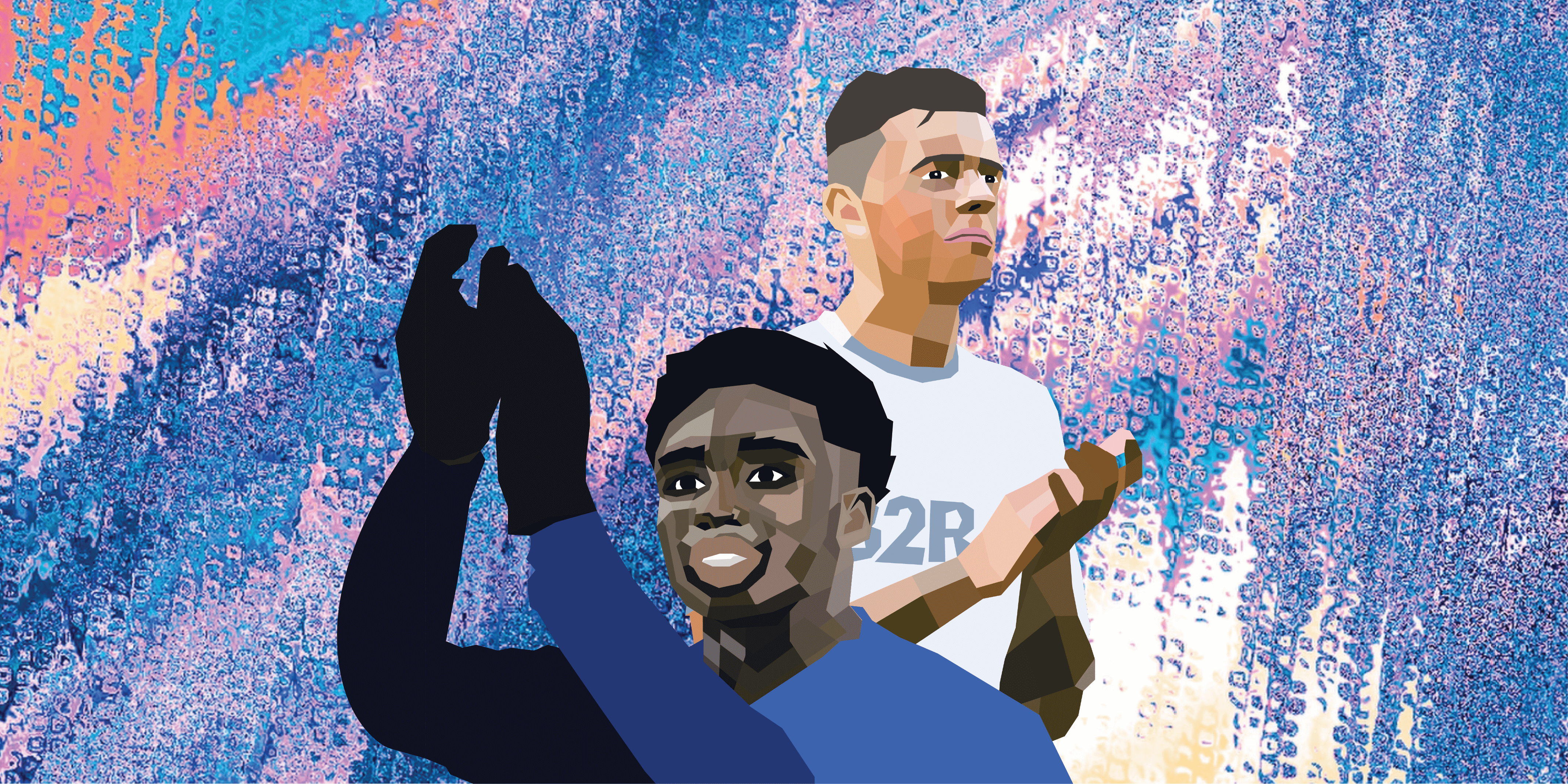



Comments